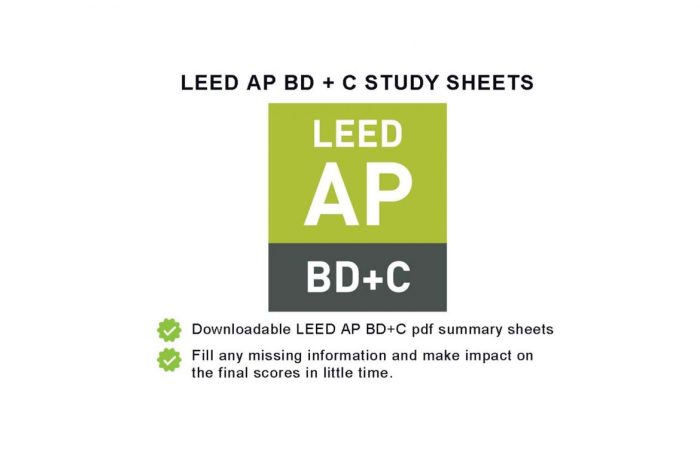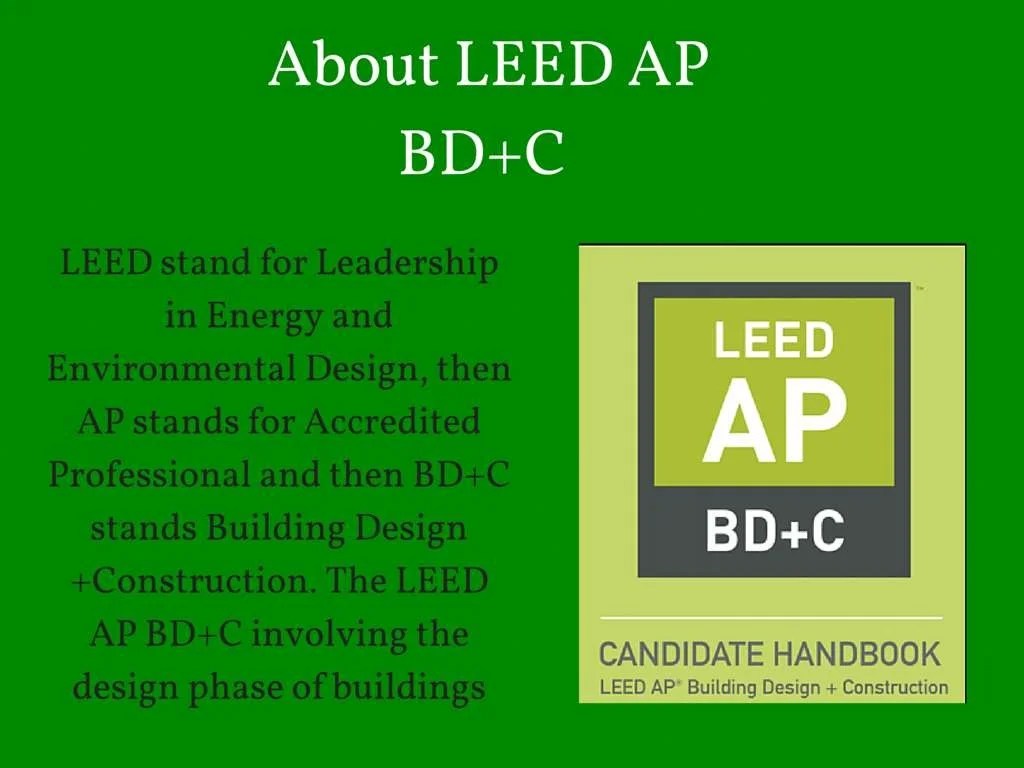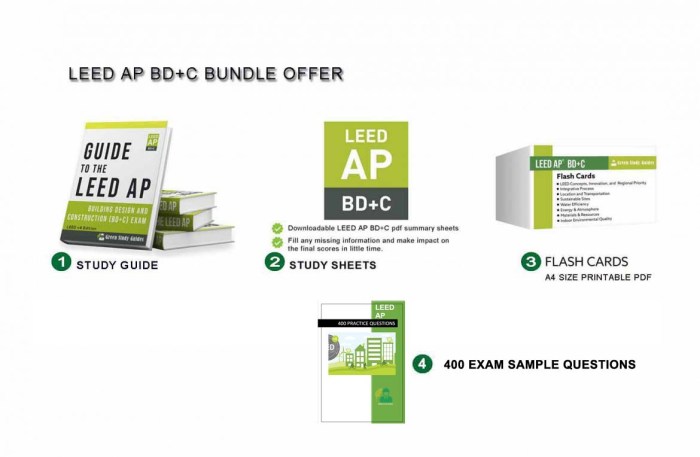Welcome to the LEED AP BD+C Study Guide, your ultimate resource for mastering the principles and practices of sustainable building design and construction. Dive into a comprehensive exploration of the LEED certification process, empowering yourself with the knowledge and skills to create eco-friendly structures that prioritize human health and environmental well-being.
As you journey through this guide, you’ll gain a deep understanding of the LEED rating system, its criteria, and the strategies for achieving certification. From sustainable site planning to energy-efficient design, water conservation techniques to indoor environmental quality, this guide covers all aspects of LEED AP BD+C.
LEED AP BD+C Study Guide Overview

The LEED AP BD+C study guide is a comprehensive resource designed to help you prepare for the LEED AP BD+C exam. It covers all of the topics that are tested on the exam, and it provides detailed explanations of the concepts and principles that you need to know.The
study guide is divided into nine chapters, each of which covers a different topic area. The chapters are:
- Sustainable Sites
- Water Efficiency
- Energy and Atmosphere
- Materials and Resources
- Indoor Environmental Quality
- Innovation
- Regional Priority
- Green Building and LEED
- Exam Strategies
Each chapter begins with an overview of the topic area, and then it provides detailed explanations of the concepts and principles that you need to know. The chapters also include practice questions to help you test your understanding of the material.The
LEED AP BD+C study guide is an essential resource for anyone who is preparing for the LEED AP BD+C exam. It provides comprehensive coverage of all of the topics that are tested on the exam, and it can help you to improve your understanding of the concepts and principles that you need to know.
Sustainable Sites: Leed Ap Bd+c Study Guide
Sustainable sites emphasize protecting and restoring natural habitats, reducing site disturbance, and minimizing stormwater runoff. These criteria encourage responsible land use and promote a harmonious relationship between buildings and the environment.
To reduce site disturbance, strategies include minimizing impervious surfaces, preserving existing vegetation, and restoring degraded areas. Additionally, implementing erosion control measures and limiting construction activities during sensitive periods can protect natural habitats.
For those pursuing LEED AP BD+C certification, understanding conversion rates is crucial. For instance, if a recipe calls for 1/3 cup of an ingredient and you need to triple the recipe, you can easily calculate the new measurement using a conversion tool ( what is 1/3 cup tripled ). This ensures accuracy in preparing materials for LEED-compliant projects, contributing to the overall success of your certification journey.
Strategies for Reducing Site Disturbance
- Minimize impervious surfaces: Reduce the area covered by paved surfaces, such as parking lots and driveways, to allow for water infiltration and reduce runoff.
- Preserve existing vegetation: Retain as many existing trees and plants as possible to provide habitat for wildlife, reduce erosion, and improve air quality.
- Restore degraded areas: Reclaim disturbed or contaminated areas by planting native species, restoring soil health, and implementing erosion control measures.
Strategies for Protecting Natural Habitats
- Implement erosion control measures: Use techniques such as silt fences, straw bales, and erosion control blankets to prevent soil erosion and protect water quality.
- Limit construction activities during sensitive periods: Avoid construction during nesting seasons or other critical periods for wildlife to minimize disturbance.
Water Efficiency

LEED’s water efficiency criteria aim to reduce water consumption and promote sustainable water management practices in buildings. To earn points in this category, projects must implement strategies that reduce indoor and outdoor water use, manage stormwater runoff, and use efficient water-consuming fixtures and appliances.
Strategies for Reducing Water Consumption, Leed ap bd+c study guide
To reduce water consumption in buildings, various strategies can be employed:
- Water-efficient fixtures:Installing low-flow toilets, faucets, and showerheads can significantly reduce water usage without compromising functionality.
- Efficient irrigation systems:Implementing drip irrigation, smart controllers, and rain sensors in landscaping can optimize water use in outdoor areas.
- Rainwater harvesting:Collecting and storing rainwater for non-potable uses, such as irrigation and toilet flushing, can reduce reliance on municipal water sources.
- Water-efficient appliances:Choosing energy-efficient appliances, such as dishwashers and washing machines, that consume less water can contribute to overall water conservation.
- Leak detection and repair:Regularly inspecting and repairing leaks in plumbing systems can prevent significant water loss.
Examples of Implementation
- A residential building in California installed low-flow toilets and faucets, resulting in a 30% reduction in indoor water use.
- A commercial office building in Texas implemented a rainwater harvesting system, reducing its municipal water consumption by 25%.
- A school in Florida installed a drip irrigation system in its landscaping, saving 40% of the water previously used for irrigation.
Energy and Atmosphere

The LEED criteria for energy and atmosphere aim to reduce energy consumption and greenhouse gas (GHG) emissions in buildings. These criteria evaluate the building’s energy performance, renewable energy sources, and the use of energy-efficient technologies.
Strategies for reducing energy consumption and GHG emissions include:
- Optimizing building envelope performance (insulation, windows, etc.)
- Using energy-efficient appliances and equipment
- Installing renewable energy systems (solar panels, wind turbines)
- Implementing energy management systems
Energy Efficiency
Improving energy efficiency is crucial for reducing energy consumption and GHG emissions. LEED encourages the use of energy-efficient measures, such as:
- High-performance glazing and insulation
- Efficient lighting systems (LEDs, CFLs)
- Energy-efficient appliances (ENERGY STAR rated)
- Variable frequency drives (VFDs) for motors
Renewable Energy
Integrating renewable energy sources into buildings is a key strategy for reducing reliance on fossil fuels. LEED promotes the use of renewable energy systems, including:
- Solar photovoltaic (PV) panels
- Solar thermal systems
- Wind turbines
- Geothermal heat pumps
Energy Management
Implementing energy management systems helps optimize energy usage and reduce waste. LEED encourages the use of technologies such as:
- Building automation systems (BAS)
- Energy monitoring and tracking systems
- Occupancy sensors
- Commissioning and retro-commissioning
Materials and Resources
LEED (Leadership in Energy and Environmental Design) criteria for materials and resources aim to promote sustainable practices in the construction industry. These criteria focus on reducing environmental impacts, conserving resources, and promoting human health and well-being.The LEED criteria for materials and resources encourage the use of sustainable materials, including recycled content, renewable resources, and materials extracted or manufactured in a responsible manner.
By incorporating these materials into building projects, architects and builders can minimize the environmental footprint of construction and reduce the consumption of virgin resources.
Strategies for Using Sustainable Materials and Reducing Waste
Several strategies can be employed to implement sustainable materials and reduce waste in real-world projects. These include:
-
-*Recycled Content
Using materials with recycled content reduces the demand for virgin resources and diverts waste from landfills.
-*Renewable Resources
Incorporating materials derived from renewable sources, such as bamboo or cork, helps conserve natural resources.
-*Locally Sourced Materials
Using materials sourced from within a specific region reduces transportation emissions and supports local businesses.
-*Waste Reduction
Implementing waste management plans, such as recycling and composting, helps minimize the amount of waste generated during construction and operation.
-*Durable and Low-Maintenance Materials
Selecting durable materials that require minimal maintenance reduces the need for repairs and replacements, conserving resources and reducing waste over the building’s life cycle.
Examples of Sustainable Materials and Waste Reduction in Real-World Projects
Numerous examples showcase the successful implementation of sustainable materials and waste reduction strategies in real-world projects. For instance, the Bullitt Center in Seattle, Washington, is renowned for its commitment to sustainability. The building incorporates recycled steel, low-VOC (volatile organic compound) materials, and a rainwater harvesting system, reducing its environmental impact and promoting occupant well-being.Another
notable example is the VanDusen Botanical Garden Visitor Centre in Vancouver, Canada. The project utilized sustainable materials such as FSC-certified wood, recycled glass, and a green roof to minimize its ecological footprint and enhance the surrounding environment.These examples demonstrate the practical application of LEED criteria for materials and resources, contributing to a more sustainable and environmentally conscious built environment.
Indoor Environmental Quality
Indoor environmental quality (IEQ) refers to the conditions within a building that affect the health and well-being of occupants. LEED emphasizes the importance of IEQ by requiring buildings to provide a healthy and comfortable indoor environment for occupants.The LEED criteria for IEQ focus on several key areas:*
-*Ventilation
Ensuring adequate ventilation rates to maintain acceptable indoor air quality and reduce the risk of airborne contaminants.
-
-*Air Quality
Controlling indoor air pollutants, including particulate matter, volatile organic compounds (VOCs), and carbon dioxide.
-*Thermal Comfort
Maintaining comfortable indoor temperatures and humidity levels to enhance occupant comfort and productivity.
-*Daylighting and Views
Providing access to natural light and views to improve occupant well-being and reduce reliance on artificial lighting.
Strategies for Improving Indoor Air Quality
Improving indoor air quality involves several strategies, including:*
-*Source Control
Identifying and eliminating sources of indoor air pollution, such as building materials, cleaning products, and office equipment.
-
-*Ventilation
Increasing ventilation rates through mechanical or natural means to dilute and remove indoor air pollutants.
-*Air Filtration
Using air filters to remove particulate matter and other contaminants from the air.
-*Moisture Control
Controlling moisture levels to prevent mold and mildew growth, which can contribute to poor indoor air quality.
Examples of IEQ Strategies in Real-World Projects
*
-*Use of low-VOC materials
In a hospital project, low-VOC paints, adhesives, and sealants were used to reduce the release of harmful chemicals into the indoor air.
-
-*Enhanced ventilation
In an office building, a demand-controlled ventilation system was installed to increase ventilation rates when occupancy levels are high.
-*Natural daylighting
In a school building, large windows and skylights were incorporated to provide ample natural light and reduce the need for artificial lighting.
Innovation and Design

The LEED criteria for innovation and design encourage projects to go beyond the minimum requirements to achieve sustainability goals. This category rewards innovative approaches to design, construction, and operation that can significantly reduce environmental impacts.Strategies for achieving LEED certification beyond the minimum requirements include:
- Utilizing innovative technologies or materials that enhance energy efficiency, water conservation, or indoor air quality.
- Incorporating renewable energy sources to reduce reliance on fossil fuels.
- Designing for adaptability and resilience to climate change impacts.
- Promoting sustainable transportation options to reduce greenhouse gas emissions.
- Implementing comprehensive waste management programs to minimize waste generation.
Examples of innovative and sustainable design solutions include:
- Green roofs that absorb rainwater, reduce heat gain, and provide habitat for wildlife.
- Permeable pavements that allow water to infiltrate the ground, reducing runoff and flooding.
- Solar-powered lighting systems that eliminate the need for fossil fuel-based electricity.
- Low-flow plumbing fixtures and water-efficient landscaping to conserve water resources.
- Natural ventilation systems that provide fresh air without relying on mechanical ventilation.
Regional Priority Credits
Regional priority credits aim to encourage projects to address specific environmental issues relevant to their geographic location. These credits provide opportunities for projects to earn points by implementing strategies that are particularly impactful in their region.
There are various types of regional priority credits available, tailored to different regions and their unique environmental concerns. These credits may focus on issues such as water conservation, energy efficiency, sustainable transportation, or waste reduction. The specific credits available in a particular region can be found in the LEED Reference Guide for Building Design and Construction.
Selecting and Implementing Regional Priority Credits
To select and implement regional priority credits effectively, consider the following guidance:
- Identify the environmental issues that are most pressing in your project’s region. Research local environmental data, consult with experts, and engage with community stakeholders to gain insights.
- Review the available regional priority credits and assess their relevance to your project’s goals and site conditions. Consider the potential impact and feasibility of each credit.
- Prioritize the credits that align best with your project’s objectives and have the greatest potential for environmental benefits. Focus on implementing credits that are achievable within your project’s scope and budget.
- Collaborate with the project team, including architects, engineers, and contractors, to ensure that the selected credits are integrated into the project design and construction process.
- Document the implementation of regional priority credits and provide evidence to demonstrate their effectiveness. This documentation may include project plans, specifications, and monitoring data.
Question Bank
What is LEED AP BD+C?
LEED AP BD+C (Leadership in Energy and Environmental Design Accredited Professional with specialty in Building Design and Construction) is a credential that recognizes individuals with expertise in sustainable building design, construction, and operation.
What are the benefits of obtaining LEED AP BD+C certification?
LEED AP BD+C certification demonstrates your commitment to sustainability, enhances your professional credibility, and opens doors to career opportunities in the green building industry.
What is covered in the LEED AP BD+C Study Guide?
Our LEED AP BD+C Study Guide provides a comprehensive overview of the LEED rating system, including sustainable site planning, water efficiency, energy and atmosphere, materials and resources, indoor environmental quality, innovation and design, and regional priority credits.